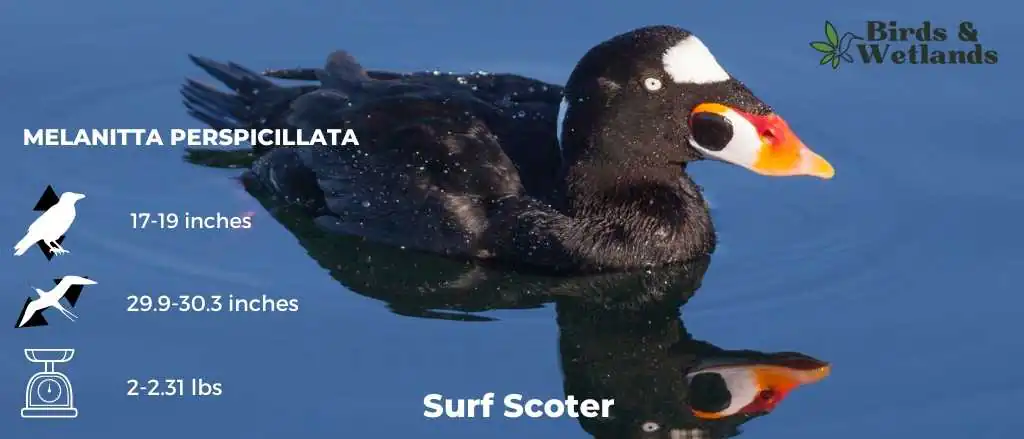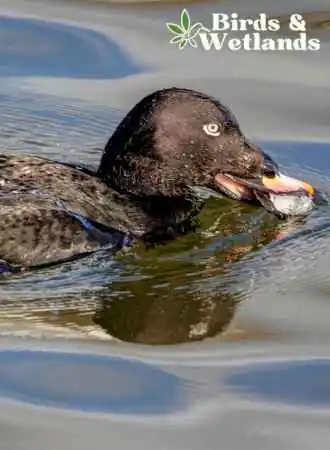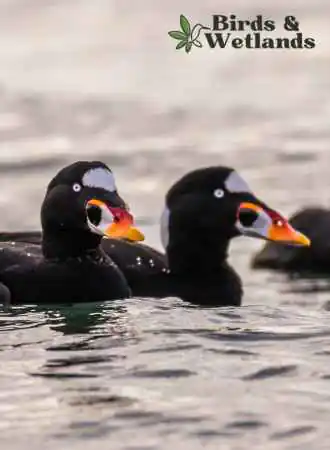
The surf scoter is a large sea duck native to the coasts of North America. It is commonly found in the northern parts of the United States and Canada. It is also known colloquially as skunkhead or skunk-headed coot.
This diving duck belongs to the tribe Mergini within the family Anatidae. Other ducks in this tribe include other sea ducks such as eiders, mergansers and goldeneyes.
Scientific Name: Melanitta perspicillata
Length
- Male: 48 cm (19 in)
- Female: 44 cm (17 in)
Weight
- Male: 1,050 g (2.31 lb)
- Female: 900 g (2.0 lb)
Wingspan: 29.9-30.3 in (76-77 cm)
Physical Description

The adult male surf scoter has a noticeable hump above its nostrils and a colorful bill that appears mostly orange from a distance. It has white patches on the nape and forehead, reddish-orange legs and webbed feet, and a white iris, which set it apart from other scoters.
Adult females and juveniles are dark brown with white patches on their face and cheeks. They have a blackish crown, dark brown eyes and a greenish-black bill, slightly smaller than the male. Interestingly, females of all scoter species share similar plumage.
Listen to the Surf Scoter
Breeding & Winter Range

The surf scoter is a unique sea duck that breeds exclusively in North America, primarily in British Columbia and other parts of northern Canada and Alaska.
During the winter months, these birds migrate using their usual migration routes to more temperate environments, with many heading to the Pacific and Atlantic coasts of North America.
The Pacific coast is home to the largest population of wintering birds. Some flocks headed south for Baja California use Puget Sound as a stopover location.
While small numbers of surf scoters winter in western Europe, including the British Isles, the vast majority stay on the North American continent.
Habitat
During the breeding season, the surf scoter is found near lakes and rivers in the boreal forest or tundra regions in the far north. These birds prefer small bodies of freshwater and sparsely forested areas and are often seen near the shoreline, diving for food in the cool, clear waters.
But as the weather turns cold and winter approaches, the surf scoter heads to the coast in search of more hospitable conditions. These birds are frequently seen in shallow waters in shallow bays, estuaries, river mouths and other coastal areas, where they can find plenty of food to sustain them through the colder months.
Feeding Habits & Diet

The surf scoter is a versatile and opportunistic feeder, taking advantage of the various food sources throughout the year. Its diet is diverse, and its feeding behaviors are adapted to the changing seasons and environments in which it lives.
During the winter months, the surf scoter’s diet is primarily composed of benthic invertebrates, small mollusks such as mussels and clams, small crabs and other crustaceans, sea squirts and hydrozoans, marine worms, and small fish like herring spawn. Its prey is available in the shallow, coastal waters where the surf scoter tends to forage.
In the summer, the surf scoter’s diet shifts to include more aquatic vegetation and freshwater invertebrates, such as aquatic insects and plant material. This change in diet reflects the availability of different food sources in their breeding areas.
As a sea duck, the surf scoter feeds by diving through the water to forage for its food. It tends to forage close to the shore, often among the breaking waves, and can be seen diving through the foaming wave crests in search of its favorite food sources.
In the winter, surf scoters often forage in large flocks, allowing them to locate and secure food in their wintering areas.
Nesting & Mating Habits
Pairs form at their wintering grounds in late winter or early spring. Like many other ducks, the surf scoter engages in elaborate courtship rituals shortly before the mating season starts.
Male scoters perform elaborate displays, including head tossing and wing flapping, to attract females. Even though males are generally silent, they may emit low-pitched noises during courtship. Once a mating pair has been formed, the couple will typically remain together for the breeding season.
Nesting season begins in mid-May to late June. Surf scoters typically build their nests on the ground, in a protected location such as a shallow depression or among tall grasses or low tree branches.
The female lays a clutch of 5 to 9 eggs into its nest, which she incubates for 25 to 30 days. The male stays for the entire incubation period and then leaves to molt and regrow flight feathers with other adult males. Females with their young may join the males at their molting sites.
The female solely participates in the rearing duties once the eggs hatch. She may join other female surf scoters to form a creche with their young. Most females abandon their young even before they learn how to fly. Young surf scoters become fully fledged 55 to 60 days after hatching.
Threats & Conservation

The surf scoter is currently listed as Least Concern by the IUCN due to its broad range. Even though its actual population trend is unknown, it is believed to be declining slowly. The population recovered after a serious decline early in the 20th century.
Nevertheless, this sea duck species is threatened by climate change and many human activities that affect its natural habitats, such as the degradation of wetlands and estuaries, oil spills and other pollution.
To help conserve the species, governments are implementing management plans aimed at reducing threats to their habitats.
Hunting
In the United States, hunting of surf scoters is regulated by state and federal laws. These laws vary by state and may change yearly, so it is important to check with the appropriate regulatory agency to determine whether hunting surf scoters is allowed in a particular location.
In addition to federal and state regulations, some localities may have laws or ordinances prohibiting or restricting hunting. Knowing and complying with all applicable laws and regulations when hunting surf scoters or other wildlife species is important.
Key Points
- Most surf scoters breed along the shores of shallow freshwater lakes in boreal forests of the northern parts of Canada and Alaska.
- Surf scoters are migratory birds traveling south from their breeding grounds to wintering grounds in the winter.
- Adult male surf scoters have colorful bills, while females and immature birds have dark bills. Both genders have large bills.
- The surf scoter inhabits both fresh water and marine habitats, showing its versatility in terms of habitats.
